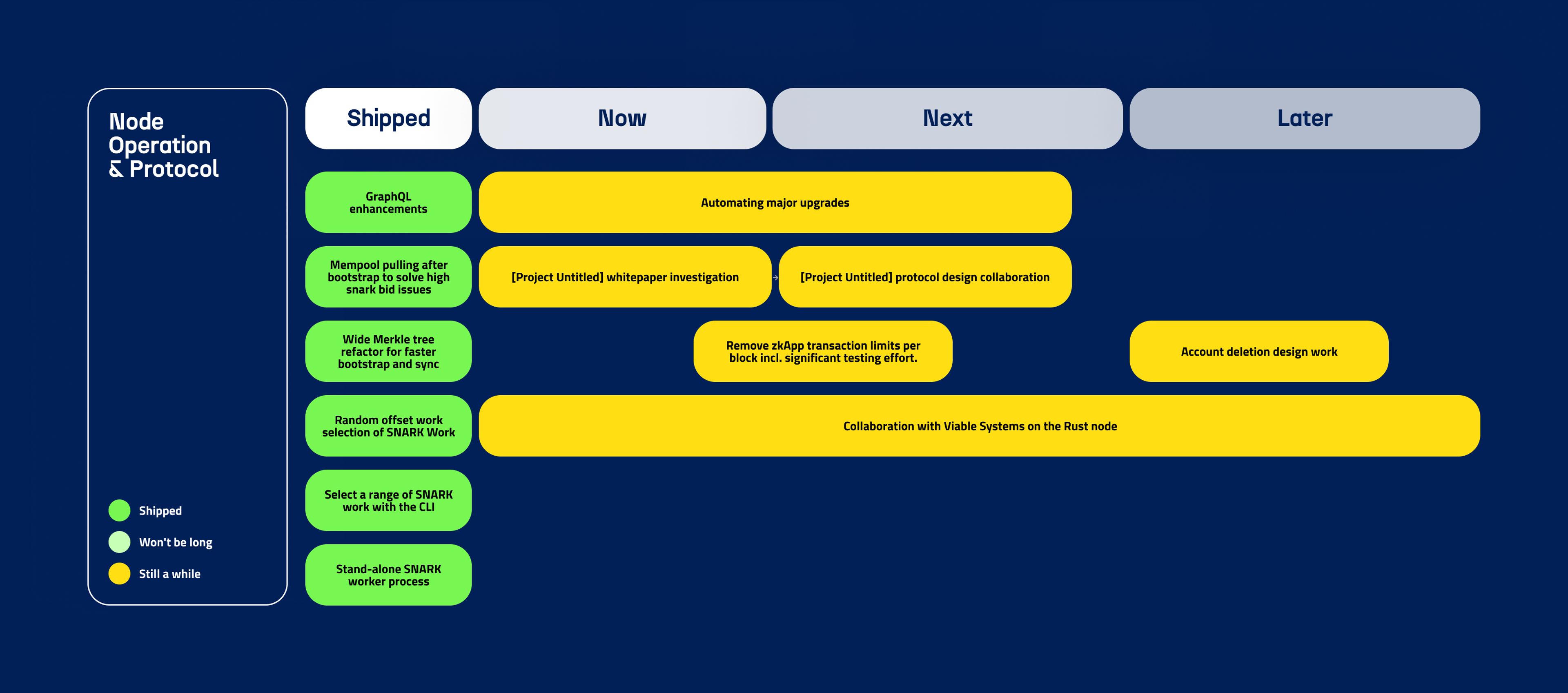This post is part of our roadmap series, diving deeper into the focus areas outlined in the o1Roadmap. Each post explores how each Engineering team at o1Labs is pushing Mina forward by covering what we’ve delivered (recent milestones), what we’re building (current initiatives in progress), and what’s next (future priorities).

As part of o1Labs' comprehensive 2025 roadmap, we're excited to share an in-depth look at our Node Operation & Protocol initiatives. This technical deep dive examines our recently shipped improvements and upcoming developments that will fundamentally enhance network performance and protocol capabilities. Our focus remains on building robust infrastructure while maintaining Mina's core principles of accessibility and decentralization.
What We’ve Delivered
Bootstrap Process Improvements
We recently completed enhancements to the Mina bootstrap process by improving ledger synchronization speed and network participation. A cornerstone of this enhancement is the integration of SNARK work synchronization immediately after bootstrap. This approach ensures nodes sync seamlessly with the network's SNARK pool, maximizing block rewards from initialization and reducing empty blocks caused by insufficient SNARK work. These improvements represent a major step forward in network efficiency and will be available in our upcoming releases.
SNARK Worker Process Enhancement
We've implemented features that fundamentally improve SNARK work efficiency at the network level, enabling node operators to precisely configure and experiment with their own SNARK work setup. Our early testers and community members have played an instrumental role in identifying both the strengths and limitations of this marketplace mechanism, helping us refine and optimize its operation. We look forward to the community using it when these are rolled out and providing feedback on Discord!
GraphQL Enhancements
We've expanded our GraphQL server capabilities with new queries and mutations, providing developers with control over more of the nodes’ state. These enhancements mark a step towards enabling more application development and improving the overall operator experience.
What We’re Building
Automated Hard Fork Mechanism
Building on our successful zkApps mainnet deployment, we've gathered valuable community and developer feedback about the hard fork process. This insight drives our current incremental development of an automated mechanism designed to streamline protocol updates while minimizing manual intervention. The system will incorporate more sophisticated safety checks and coordination mechanisms to ensure smoother transitions between protocol versions.
zkApp Transaction Limits
We will work towards eliminating the current 24-transaction-per-block limit for zkApps. This, combined with substantial RAM usage optimizations, will dramatically expand both network processing capabilities and potential zkApp use cases. The removal of these constraints benefits developers building sophisticated multi-transaction applications and users requiring higher throughput.
Rust Node Implementation
Our collaboration with Viable Systems on their Rust node implementation represents a significant step toward network diversity. We commit to conducting comprehensive code reviews and rigorous audits to ensure complete feature parity with our existing implementation. We are excited about this parallel implementation that will provide operators with more choice while enhancing network resilience.
Protocol Analysis for [Project Untitled]
We're developing an innovative, decentralized state management solution designed to serve both the Mina ecosystem and the broader Web3 landscape. Our team is conducting extensive investigations into protocol design, addressing both theoretical foundations in our whitepaper and practical implementation considerations. This initiative aims to solve fundamental challenges in decentralized storage while maintaining the commitment to succinct blockchain architecture.
What’s Next
While our immediate focus remains on the initiatives detailed above, our roadmap extends further to include features such as account deletion capabilities.
This technical roadmap represents our commitment to strengthening Mina's core infrastructure while pushing the boundaries of what's possible in blockchain technology. Each improvement, from our recently shipped features to our ambitious upcoming developments, is a carefully considered step toward building a more powerful, accessible, and efficient protocol.
We continue to actively incorporate feedback from our vibrant community of node operators and developers, ensuring our technical decisions address real-world challenges and opportunities. This collaborative approach, combined with our rigorous technical standards, drives Mina's evolution as a leading platform for programmable cryptography.

